MARIANI’S
Virtual
Gourmet
February
13 2022
NEWSLETTER
ARCHIVE

Keira Knightley in "Anna Karenina" (2012)
IN THIS ISSUE
SURVIVING DINING OUT WITH THE KIDS
By John Mariani
NEW YORK CORNER
HANCOCK STREET
By John Mariani
ANOTHER VERMEER
CHAPTER SEVEN
By John Mariani
NOTES FROM THE WINE CELLAR
THE VARIETY, VERSATILITY AND VALUE
OF CRU BEAUJOLAIS
By John Mariani
❖❖❖
 Underground History. Go to: WVOX.com.
The episode will also be archived at: almostgolden.com.
Underground History. Go to: WVOX.com.
The episode will also be archived at: almostgolden.com. 
❖❖❖
SURVIVING DINING OUT WITH THE KIDS

By John Mariani
The first time I took my
first-born son to dinner he was three weeks old
and strapped to my chest in a Snugli. Frankly, I
would have preferred to be out with just my wife
after 21 days of sleepless nights and constant
fretting, but since we couldn’t get a sitter and
desperately needed a night out, he came with us.
He slept through the meal.
We later took him to restaurants in France
and Italy, carrying him in an open straw basket,
praying he wouldn’t wake up just as the sommelier
was opening the wine. We found out quickly that
Italians adore having babies and children in their
restaurants, while the French love having dogs but
abhor having children in the dining room.
I recall one restaurateur in Alba., Italy,
picking up my fifteen-month-old son and handing him
to his wife, who was also the chef; she, in turn,
plopped him down in the kitchen, where other women
entertained and fed him while we dined blissfully
for the next two hours, pretending to be unaware
that our son had disappeared into the steamy,
wonderful aromas of the kitchen.
After
that, he rarely balked at going out to dinner with
us. Nor did his brother, born four years later, when
the two of them were actually old enough to sit at a
restaurant table and behave in some civil fashion. I
don’t know why, but American parents seem challenged
by the idea of taking their kids to dinner—as
opposed to a fast food joint of the kids’
choosing—while in Europe and Asia parents believe
such activity is crucial to a child’s education,
health and well being.
Well, maybe not the French so much.
That said, here are some tips for taking
(American) kids out to eat.
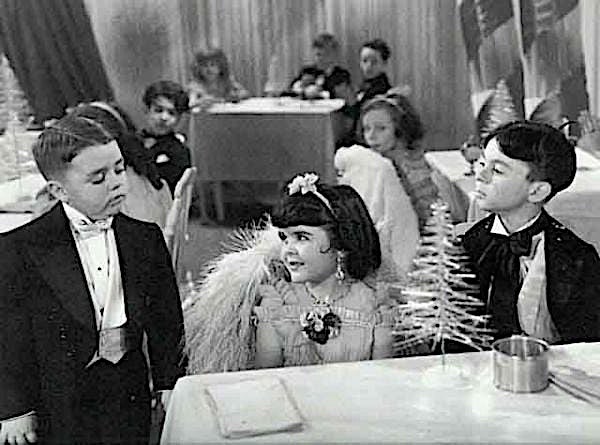
Favor
Italian, Mexican or Chinese restaurants, because
invariably the kids will find something crispy,
fried, or with cheese on it. Wherever there are
noodles there is a high probability the kids will
eat them.
Don’t let them order. Just choose
several items, especially those they are not
familiar with, and have the waiter set them all on
the table family-style. When they ask, “What’s
that?” just say, “Try it.” If they say, “What if I
hate it?” reply, “Then don’t try it.” I can
guarantee their appetites and salivary glands will
propel them to try something, maybe everything, as
long as you don’t try to force them to. And they will like
it and become more and more adventurous.
Tell
the manager or waiter to get something to nibble on
to the table immediately—bread and butter, Mexican
chips, Chinese noodles. Kids’ blood sugar levels
cause them to be cranky if not fed when hunger
strikes.
Be prepared to
order quickly for the same reason. Don’t dawdle, or
let your wife declare, “Oh, everything looks sooooo good,
I don’t know what to choose.” The
one-minute-forty-five second rule should be enforced
that everyone has to make a choice within that time
frame. In most cases you can look up the menu
on-line beforehand and know what to order as soon as
you sit down.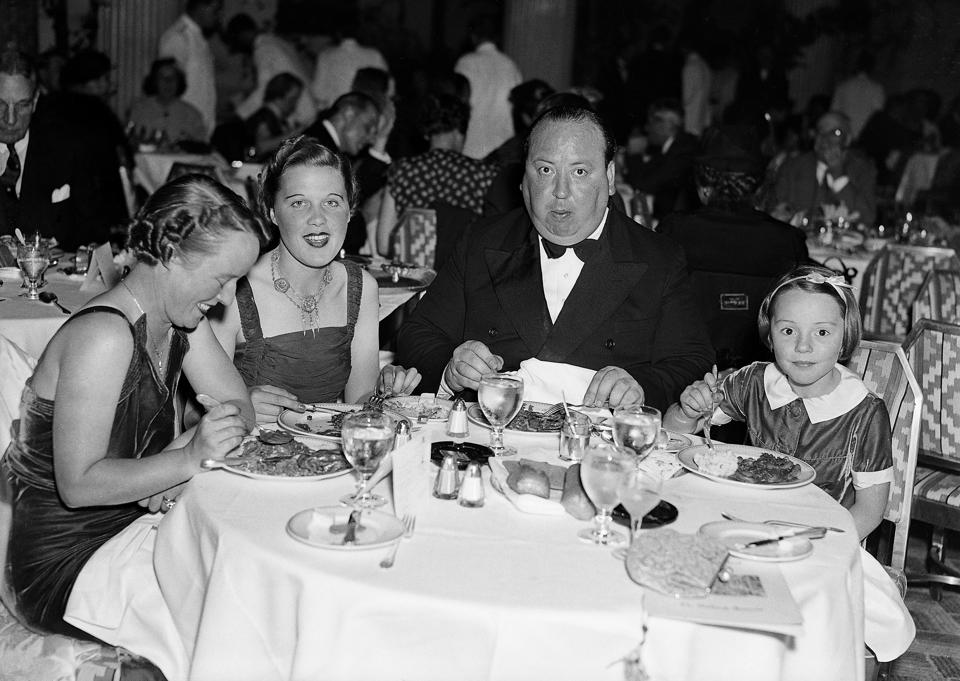
Ask for a table near the rest rooms and
one you can get up from easily. You know why.
Small children might be allowed small
toys at the table, but stifle their mania for
playing video games at the youngest possible age.
Same with iPhones and Blackberries when they get
older.
See
if you can get a female server. I have
found they tend to be much more patient, even
maternal, when dealing with children.
Dessert should be a reward for good
behavior. Carrots and sticks still work.
If you must take children to a fancy,
deluxe restaurant, alert the manager and tell him
you will be in and out in a civilized 90-minute
span. Get the check when you order dessert.
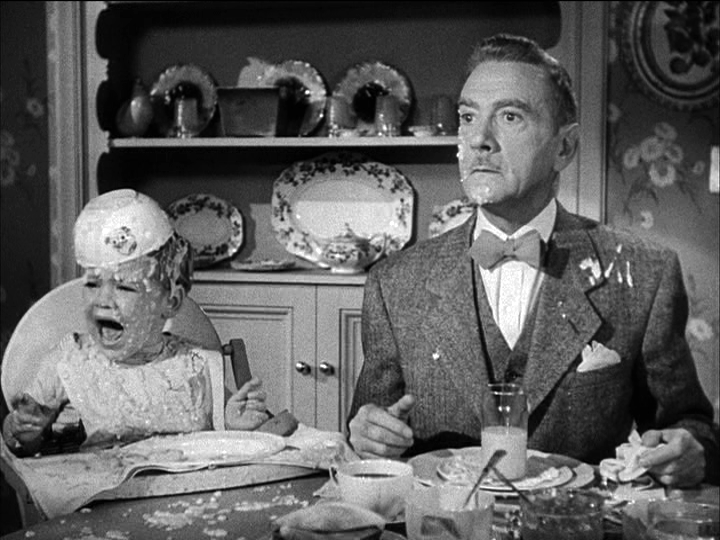
The cut-off age you can expect kids to
behave at a restaurant is twelve, after which
teenagers are impossible to please because they can
think of nothing more repellent to them than being
seen eating out with their parents.
It’s also when they start to concoct
their own idiotic diet requirements and suddenly
find everything you’d suggest from a menu abominable
or inedible. Wait
till they’re eighteen—at least your daughter—then
try to coax them out to a fine restaurant.
If a kid has gone vegetarian, just
check the restaurant’s menu on-line and tell the
management, who can advise whether a dish has any
animal or dairy products in it. In most restaurants
it’s not a problem at all. But, if the kid has gone
vegan (where did you go wrong?), there is no way in
hell you will ever
please him or her, so just forget about going out
entirely.
❖❖❖
HANCOCK STREET
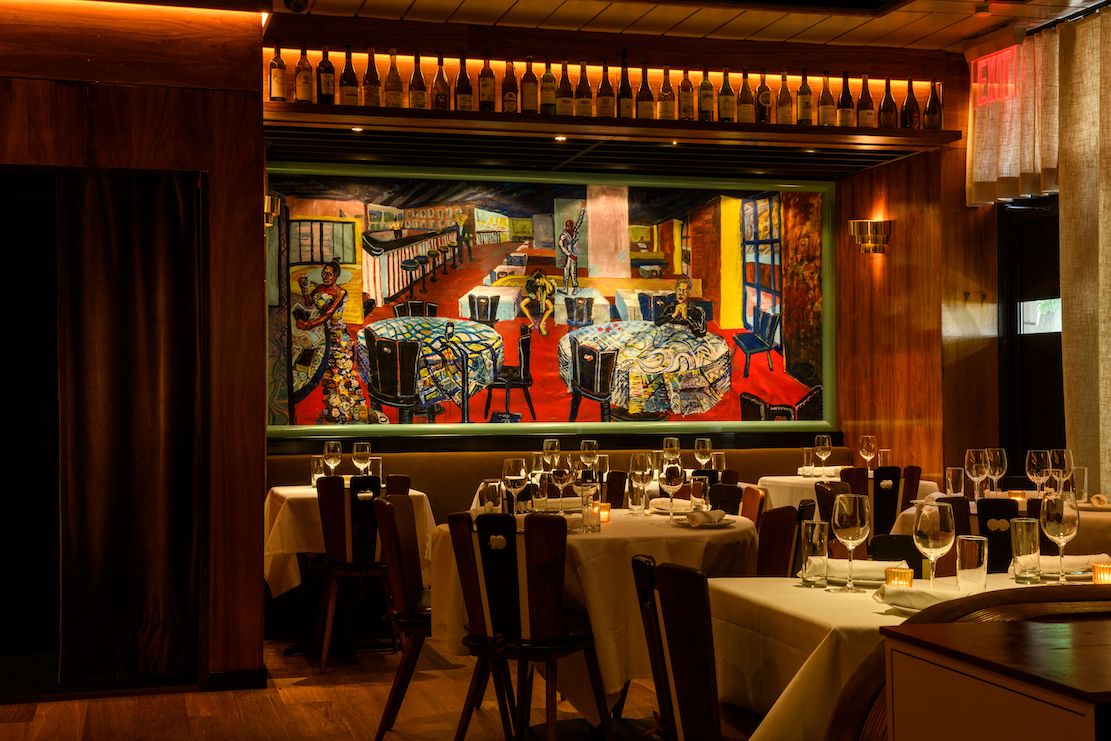
By John Mariani
Photo: Evan Sung
At a
time when so many restaurants are either
outlandishly decked out or barely decorated at
all, Hancock Street comes as a refreshing lull of
a place where a sense of Old New York intimacy is
key to its considerable charms.
The city has few such places left that evoke
a less frantic “scene” in which concept takes
precedence over hospitality and cooking. The Waverly
Inn, Landmark Tavern, Pete’s Tavern, P. J. Clarke’s
and One If By Land, Two If By Sea are all still
open, and Hancock Street is most certainly one of
the best, both in terms of creature comfort and in
comfort foods.
You might expect that from Mercer Street
Hospitality, headed by John McDonald, which also
runs the affable Lure Fishbar, Bistrot Leo,
Butterfly Soho and Bowery Meat Company. And the
experience of chef Ryan
Schmidtberger (below), formerly of Lure
Fishbar and The River Café, assures a modern take
on American cuisine. They even have a “Prime Rib
Night” on Saturday, which sells out with local
residents.
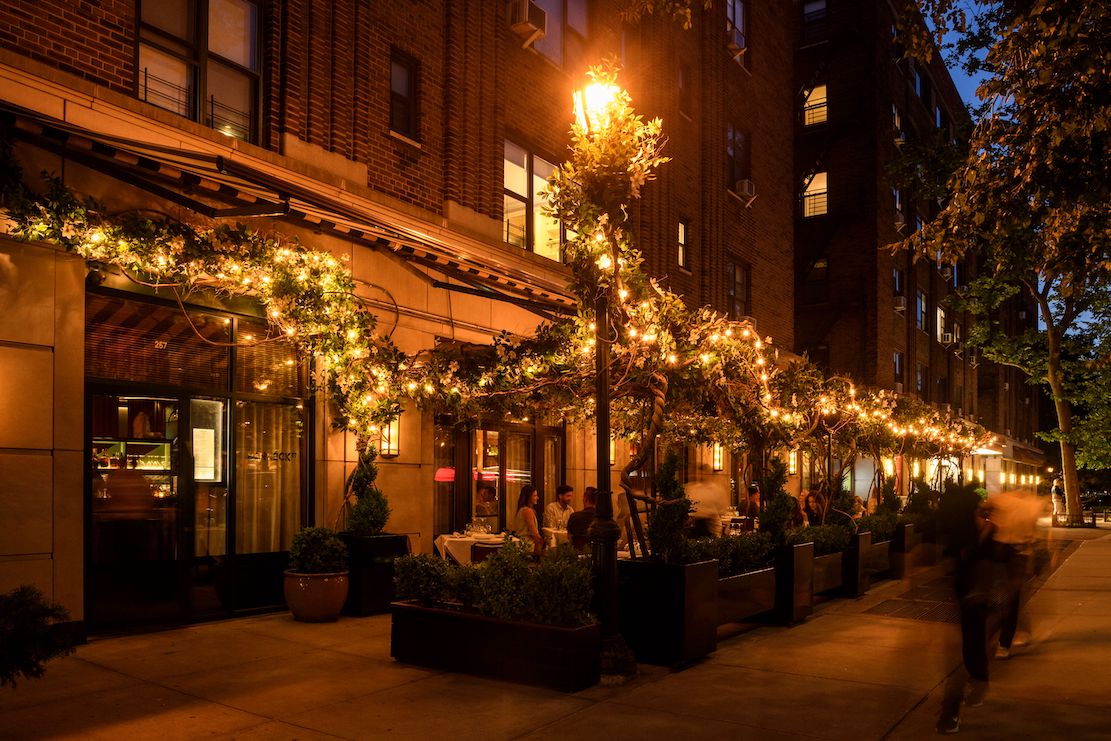 On a
cold winter’s night Hancock Street (named after a
long-gone street in the West Village) provides a
neighborly respite. It’s not a big place, so it’s
rather cozy, with an expanse of polished wood walls,
velvet curtains, a beautifully lighted bar, white
tablecloths and thin stemware. There’s also a
vividly colored mural that reflects, mirror-like,
the dining room itself. Soft lighting throughout is
crafted to provide warmth. The only off-note one
night was some loud piped-in music that I asked to
be turned down. (As in all the restaurants in the
world that have background music, it should stay
there.)
On a
cold winter’s night Hancock Street (named after a
long-gone street in the West Village) provides a
neighborly respite. It’s not a big place, so it’s
rather cozy, with an expanse of polished wood walls,
velvet curtains, a beautifully lighted bar, white
tablecloths and thin stemware. There’s also a
vividly colored mural that reflects, mirror-like,
the dining room itself. Soft lighting throughout is
crafted to provide warmth. The only off-note one
night was some loud piped-in music that I asked to
be turned down. (As in all the restaurants in the
world that have background music, it should stay
there.)
Photo: Evan Sung
Even the outside shed, in contrast to so many
barebones, jerry-rigged eyesores around town, is
beautifully lighted and set with greenery, with a
glowing old-fashioned street lamp. It almost makes
you think an Irish police officer in a long,
brass-buttoned coat will come down the block 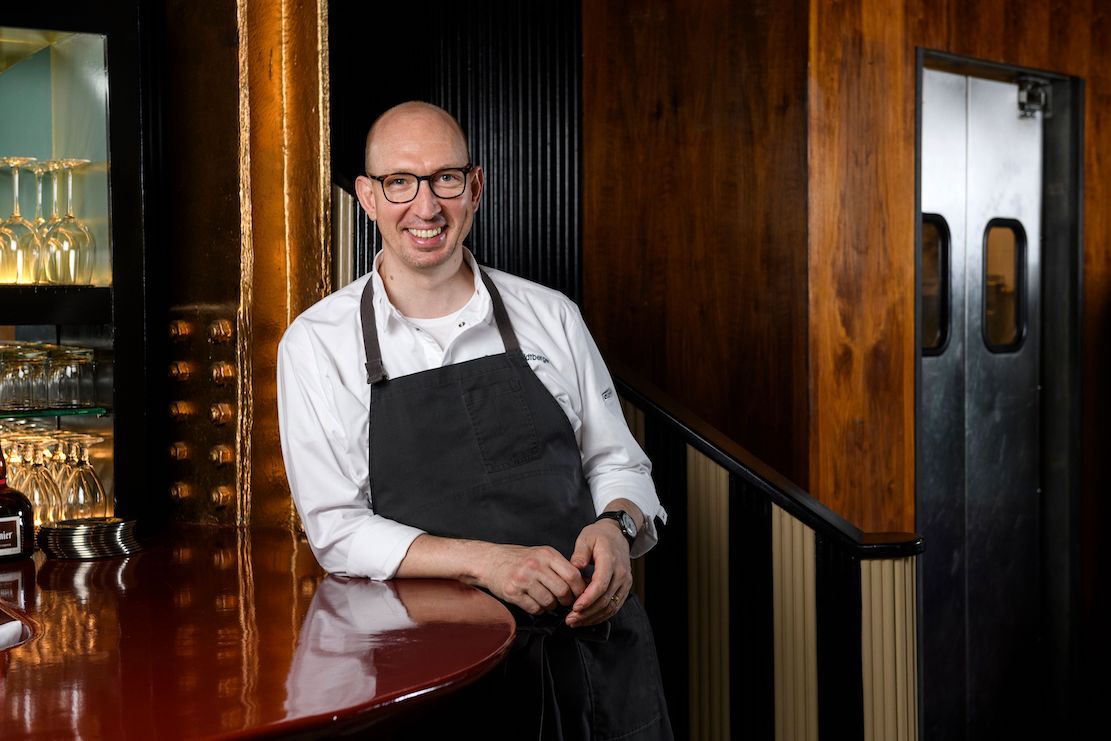 whistling
“Sidewalks of New York.”
whistling
“Sidewalks of New York.”
What I found remarkable about Schmidtberger’s
menu is that he is showing off a talent for
balancing, redeeming and refining classic dishes you
might find at any number of restaurants in New York
with his own bright new ideas. He does so with a
panache that makes his seemingly simple tartares the
best in the city—perfect temperature, subtly
seasoned and textured, accompanied by just one or
two other ingredients.
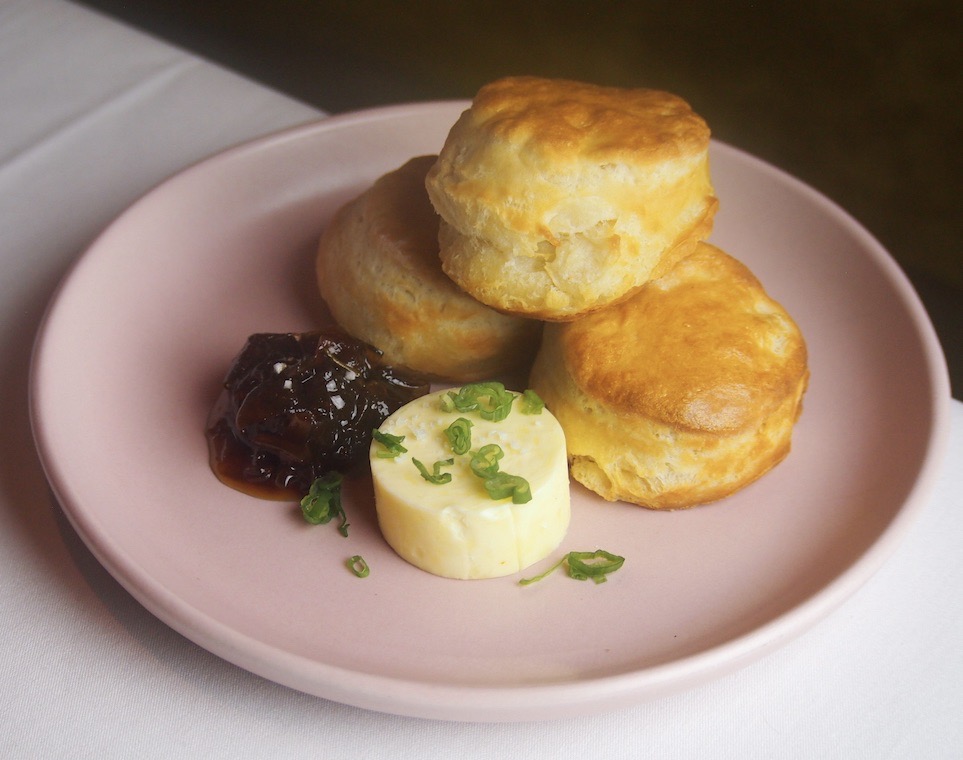 Thus, yellowfin tuna with sesame,
truffle-yuzu sauce and scallions comes on crispy
potato hash browns ($21), while steak with its own
deep flavor is impeccably chopped into a tartare
with a Coloratura anchovy vinaigrette, spicy tofu
sauce, crispy wontons and celery leaves ($23).
Schmidtberger uses nothing less than Scottish salmon
as a palette for crispy potato, capers, cucumbers
and sesame soy ginger sauce ($18). If you’re up for
it, you can go all-in with a service of Osetra
caviar with sour cream and onion potato chips and
crème fraȋche (four to eight ounces at $165 to
$295).
Thus, yellowfin tuna with sesame,
truffle-yuzu sauce and scallions comes on crispy
potato hash browns ($21), while steak with its own
deep flavor is impeccably chopped into a tartare
with a Coloratura anchovy vinaigrette, spicy tofu
sauce, crispy wontons and celery leaves ($23).
Schmidtberger uses nothing less than Scottish salmon
as a palette for crispy potato, capers, cucumbers
and sesame soy ginger sauce ($18). If you’re up for
it, you can go all-in with a service of Osetra
caviar with sour cream and onion potato chips and
crème fraȋche (four to eight ounces at $165 to
$295).
Before I go further, I must beg you to order the
biscuits (right; photo Dan Krieger) at
Hancock Street, for, while they are far from
traditional Southern-style, they seem to take the
best of that idea wedded to a Parker House roll. (It
reminds me of the rich, yeasty Cajun buns Paul
Prudhomme used to serve at K-Paul’s in New Orleans.)
Everyone in town has pastas
on the menus, and so does Schmidtberger, but, again,
while not particularly true to any Italian region,
his are expressive of his desire to please. The
flower-like campanelle
and Italian sausage are sautéed with cherry
tomatoes, burrata, shaved fennel and chili flakes
for real bite ($29), and whole wheat, rippled-edged
malfadine
(below; photo: Dan Krieger) with a rich duck
bolognese contains shiitake mushrooms and rosemary
Manchego cheese ($31), both in
portions worth sharing. 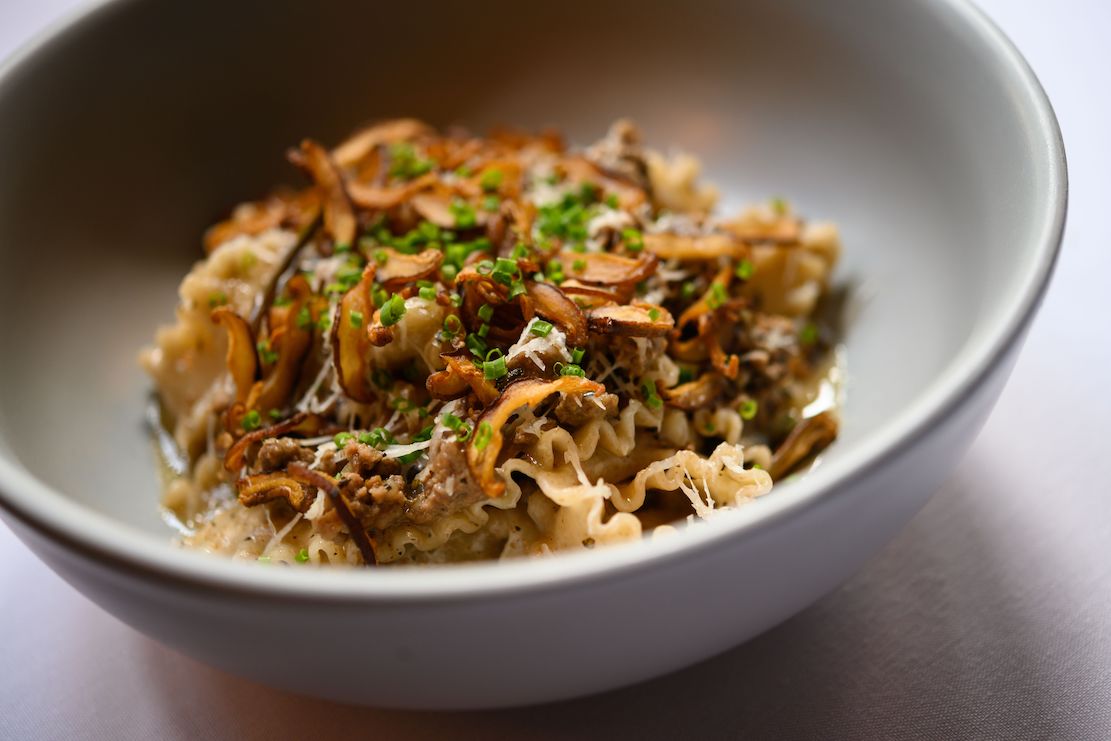
I shied away from an item called “Adult Kid’s
Pasta” ($27), but Schmidtberger urged me to try it,
and the description is happily apt. For, although
it’s basically shell macaroni with butter and
cheese, the cheese is first-rate, two years aged
Parmigiano-Reggiano, and the butter is cultured
in-house. It is marvelously rich, wholly satisfying
and will bring out the child in anyone no matter
what age.
A grilled Mediterranean branzino ($39) is
competently rendered, with grilled artichoke hearts,
preserved lemon vinaigrette and a lovely tangy
remoulade, while a roasted Amish chicken with
Brussels sprouts, onion and truffle ($36) is very
generous, with crisp skin and a deeply flavorful
reduction. You can get steak frites all over town,
and Hancock Street’s ($58), made with grilled
sirloin, comes with tarragon-dusted fries, chives
and a mildly hot pepper sauce. The slightly smoked
double pork chop ($46) is fashioned to be brought
home for lunch, receiving its flavors from butternut
puree and a grain mustard jus.
Crispy veal schnitzel with dill potatoes and
lemon caper butter ($46) is as close as you’ll come
to any outside of Vienna. And the Schmidtberger
Burger (below; photo Dan Krieger), with
pickle, onion, lettuce, white cheddar, yellow
mustard, ketchup, mayo on a sesame brioche with
terrific fries ($28), is just shy of gilding the
lily at a time when too many chefs just load things
on top of the meat and bun without any sense of
excess.
 I
suspect the child in any adult will also love the
chocolate mousse layer cake with candied violets and
ginger ($15); the apple pumpkin cranberry crumble
with salted caramel ice cream and a touch of thyme
($14), which is just about perfect for a blustery
January night; and, as you might expect by now, a
plate of warm chocolate chip cookies with dark
chocolate ice cream and a sprinkling of sea salt
($14).
I
suspect the child in any adult will also love the
chocolate mousse layer cake with candied violets and
ginger ($15); the apple pumpkin cranberry crumble
with salted caramel ice cream and a touch of thyme
($14), which is just about perfect for a blustery
January night; and, as you might expect by now, a
plate of warm chocolate chip cookies with dark
chocolate ice cream and a sprinkling of sea salt
($14).
So, if you are a New
Yorker, you will find Hancock Street both a
throwback and a beacon of good, old-fashioned taste
with thoroughly contemporary flair. If you are an
out-of-towner, Hancock Street will give you a
gratifying sense of the way Greenwich Village can
still be.
Note: NYC Health Dept. rules require both staff and guests 12 or older to show proof they have received at least one dose of a COVID-19 vaccine.
ANOTHER VERMEER

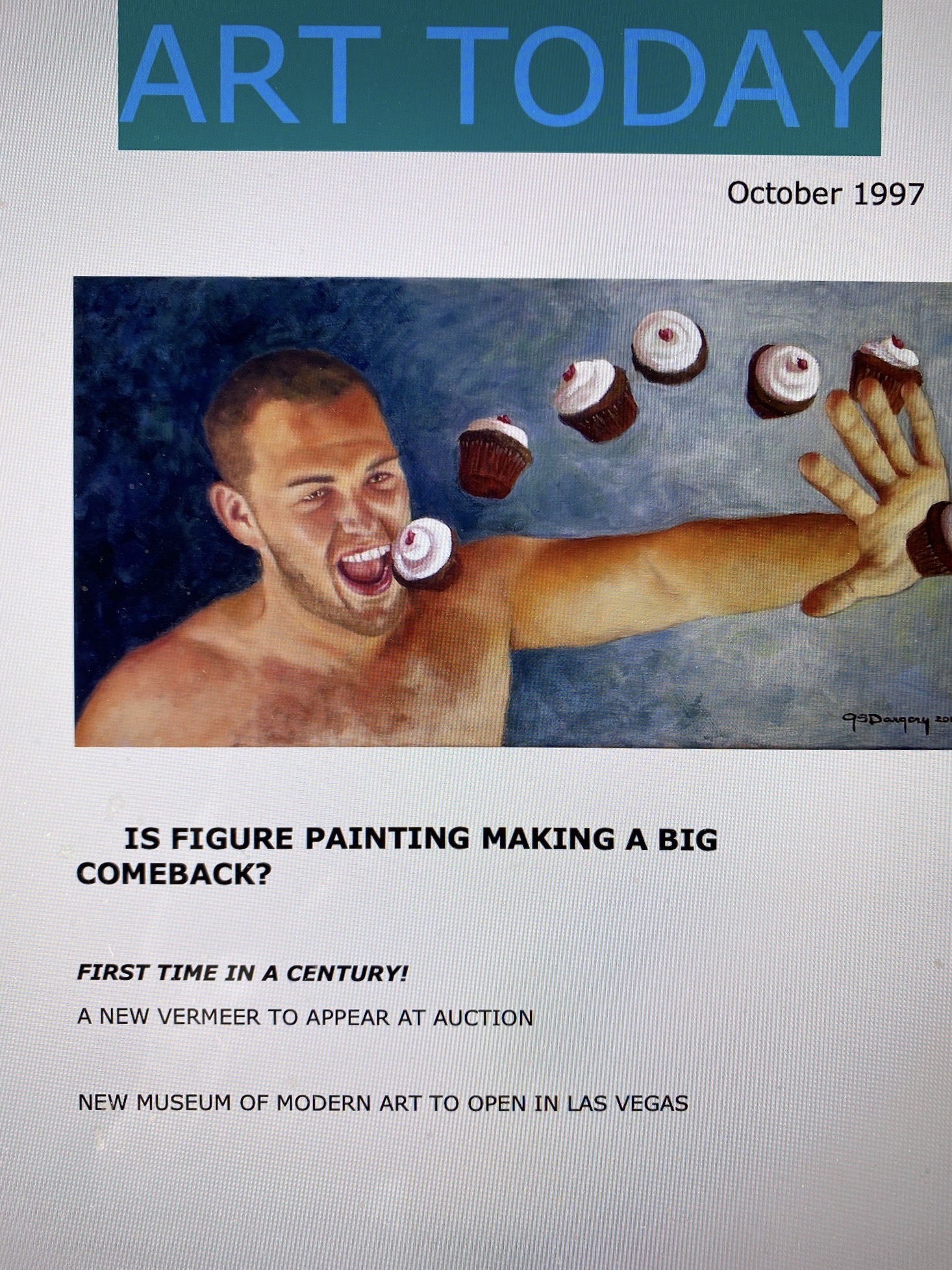 Katie picked
up the check—she put it on her expense account and
reminded David to keep all his receipts—then they
agreed to speak next whenever either had some
news. Her
next stop that afternoon was with John Coleman,
editor at Art
Today, the magazine that broke the Vermeer
story, beating out even the more established trade
journal Art
+ Auction.
Katie picked
up the check—she put it on her expense account and
reminded David to keep all his receipts—then they
agreed to speak next whenever either had some
news. Her
next stop that afternoon was with John Coleman,
editor at Art
Today, the magazine that broke the Vermeer
story, beating out even the more established trade
journal Art
+ Auction.
His office was downtown, near Union Square,
and, except for the mock-up pages on the wall for
the next issue and the postcard-size copies of staff
members’ favorite artwork, the single floor was
devoid of decoration. Katie had known John Coleman
since he’d been a general arts editor at The Village
Voice, and he knew everyone in the New York
art world, from gallery owners and curators to
painters and sculptors and their agents. Art Today came out monthly and,
despite its subject, there was little money for
glossy repros of the works of art they wrote about.
“Good God, Katie,” said Coleman, his hands on
his hips. “You still look like you just got out of
high school.”
“I skipped two grades,” she replied. “And you
always look the same.”
“Believe me, if this job paid more, I’d look
different all the time, but I’m forced to choose a look, one
that’s easy to find in the dark every morning.”
That look was indeed always the same: black
jeans, white button-down shirt, black blazer, black
loafers and a black knit tie stuffed in a pocket, in
case he needed to wear one. Coleman was about
thirty-five, slender and maintained a constant
three-day’s growth of beard beneath long,
gray-streaked dark hair. He always looked as if
morning had come way too early, whatever hour he
crawled out of bed.
“So, you said you’re working the Vermeer
story for McClure’s—a
story you know we broke,
so don’t expect me to give away any proprietary
secrets on this one. Plus, I’m sure McClure’s is
probably paying you more money for your article than
I see in a month.”
Katie just smiled and said, “That’s my
proprietary secret. So, at least tell me this out of
noblesse oblige: If you’re going to break more news
on this story, can you give me the leavings in the
corral? You know, the stuff you don’t use?”
Coleman shrugged. “That depends upon the
leavings. You know, we’d like to keep ahead of this
story now that we broke it.”
“Fair enough. Just indulge my calling you and
asking questions and keep me from wasting my time
going down blind alleys.”
“All right, that’s fair enough. I always
speak to the press, as long as I get a quote and a
plug for the magazine out of it. But you’ve gotta
promise me in return than if you get
some solid lead, you’ll at least alert me. Tit for
tat, O.K.?”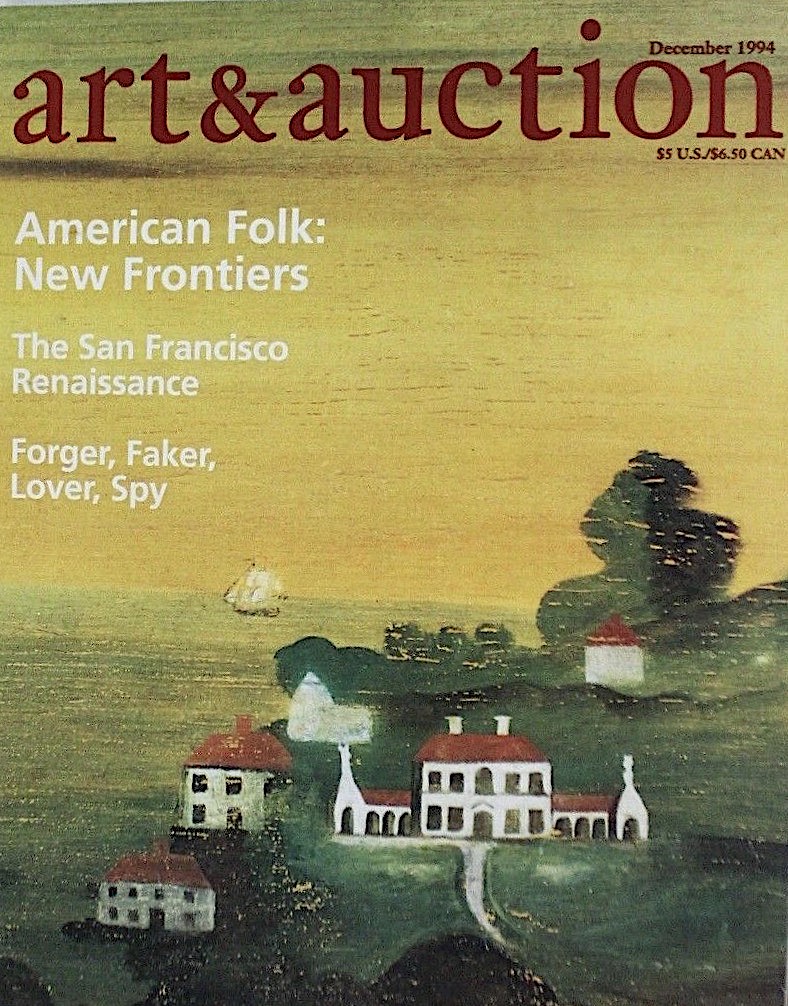
Coleman put out his hand and Katie shook it
and said, “Deal. Now can I ask you some questions
you may be able to answer?”
“Shoot.”
“Well, when you first got your tip . . .”
“It wasn’t a tip. It was an announcement that
the sale would take place.”
“And you know the name of the person who made
the announcement?”
“Yes, but I can’t reveal that at this point.”
“Man? Woman?”
“Woman.”
“Someone prominent in the art world?” asked
Katie.
“Well, I’d say someone who’s been trying to
get some leverage in the art world.”
“An agent acting for a collector?”
“Probably more of a go-between. I don’t know
if she even knows who the seller is. All she
told me was what was in our article. It wasn’t much,
but it’s sure blown the doors off the establishment.
You can’t imagine how many inquiries I’ve had to
fend off. Why,
I even have Katie Cavuto of McClure’s
in my office right now asking questions.”
“Well, tell me this much,” said Katie. “Are
you very sure the story is legit? Could it be just a
well-founded rumor?
Did you check it out with another source?”
“No. That’s just how we reported it: Simply
that a reliable person in the art world said that
soon an unknown Vermeer would be coming up for
auction and that the seller wished to remain
anonymous. That type of thing is what Art Today
is built on, but it’s not every day, not even every
century, when it involves an unknown Vermeer.”
“But she did give you the name of the
painting as The
Chemist, right? And there’s no such painting
by that name in the known Vermeer catalog, correct?
So there’s no chance this could be the Vermeer
stolen from the Gardner Museum in Boston?”
Coleman took a moment then said, “That’s the
premise we’re working on. It’s a painting new to the
art world. It might have been in the late 17th
century sale of Vermeer’s works, many of which are
unaccounted for.
But the Gardner painting? I don’t see that
happening. It’s too well known.”
“But there’s a $5 million reward still on
it.”
“Hmm, I see you’ve been doing your homework,
Cavuto. But
in that case, who would get the money? It’s still a
stolen work and you can’t put that up for auction.
It would belong to the Gardner museum.”
“True,” said Katie. “But what if the
announcement of an auction is just a fake? What if
this anonymous seller just wants to stir up frantic
interest and demand much more money from the Gardner
than the measly $5 million. I hear the thing might
soar past $100 million at auction. Plus a ten to
fifteen percent commission for the auction house.”
“But why not just approach the Gardner,
without telling us—the media—that this is a new
painting that’s going to auction?”
“Hmm, I guess you’re right. Doesn’t make much
sense.”
Then Katie snapped her fingers and said, “But
wait a minute. What if the seller is trying to build
up such excitement about the sale that it leaps beyond
current expectations? What if the buzz around the
art industry was that the work could go as high as
$120 million or more? Then, the seller—or the guys
who stole it—could always yank it back from an
auction and make a much better deal at a much higher
price with the Gardner.”
Coleman’s eyebrows rose halfway to his
hairline. “God, I never thought of that. It’s damn
risky, but it could unwind that way. If the
Gardner pays even an exorbitant price for it . . . I
shudder to think how cheap they got it for
originally . . .”
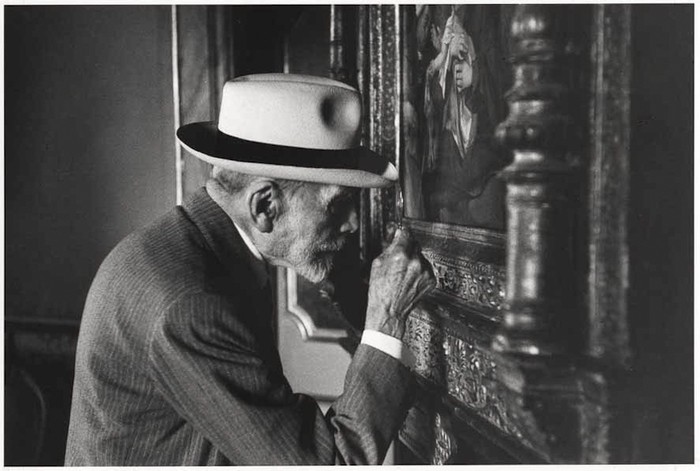 “When was that?” asked Katie.
“When was that?” asked Katie.
Coleman reached for a folder on his desk and
turned over a page.
“Gardner acquired it in . . . 1892, and it
was bought for her by Bernard Berenson (left).”
“Who was that?”
“Berenson was a famous—some say
notorious—critic and dealer who was hired by
America’s Gilded Age filthy rich to buy Old Masters
by the truckload. And, since Vermeer was not so
highly regarded at the time, who knows? The painting
might have been part of a buy-two-Rembrandts-and-
get-a-free-Vermeer bargain.”
“So, you’re saying that, if Gardner paid next
to nothing on a painting that could now bring over a
hundred million, they’d probably pay a lot more than
five million to get it back.”
“That sounds about right,” said Coleman. “You
may really have something there, Katie. Just for
that, I may want to work a little more closely with
you than I said before. If I had
some booze in my drawer, I’d toast to us.”
“Ah, John, I’m contracted at the hip for the
moment to David Greco on this story, so let’s just
leave our theories and propositions about the case
between us.”
“So this is now a . . . case?”
“Slip of the tongue.”
“Because, you know, Katie, even if all you
say might be true, there’s nothing illegal about the
Gardner paying a ransom.”
“It’s extortion, isn’t it?”
“Not if the injured party doesn’t report it
as such.”
“All the more reason for me to dig deeper and
find out what’s gong on.”
*
*
*
The
caller, as usual, spoke in very short sentences.
“Tell me what is happening with the media,”
he said.
“Everything is going according to plan,”
said the person on the other end of the line. “The
announcement in Art Today has sent the
art world into a feeding frenzy, and it seems to
get more coverage every day.”
“You mean in the New York market?”
“Oh, no. This thing is global. Everyone in
the market is watching this very closely.”
“Do you have a figure in mind?”
“I believe the painting will sell well in
excess of $100 million, perhaps much more. It will
probably be the largest price ever paid for any
work of art.”
There was a pause, then, “I do not intend
to pay that kind of money.”
“Understood. So I’ll wait for your call.
But what if I need to reach you?”
But the caller had already hung up, with
nothing but an annoying buzz left on the line.
© John Mariani, 2016
❖❖❖
THE VARIETY, VERSATILITY AND VALUE
OF CRU BEAUJOLAIS
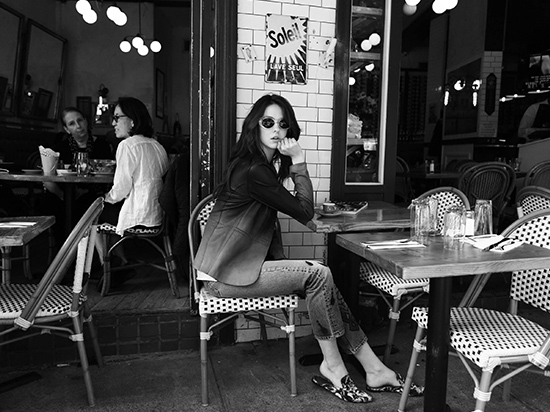
By John Mariani
The mystique of the famous Burgundy wines
from the Côte d’Ôr and Côte de Nuit like those of
Domaine Romanée Conti, which can easily sell for
$1000 a bottle, has unfortunately overshadowed the
wonderful array of wines of the region, from
Chablis in the north to Mâcon in the middle and
Villefranche in the south. Among such wines,
Beaujolais is probably both the most familiar yet
the least valued; often wine lovers don’t even
think of it as a Burgundy.
 Largely this
impression is the result of the giddy fad, beginning
in the 1970s, for Beaujolais Nouveau, the just-made,
unfinished, unaged fruity wine of autumn released in
the third week of November, heavily promoted by the
late Georges Duboeuf, who produced oceans of the
stuff for parties that began when the wines (already
stocked away) reached the stores. It was all a great
deal of fun, and, though the fad for the
Nouveau wines faded, cru Beaujolais from ten
approved regions released many months, or even
years, after vinification had trouble finding
traction as a serious wine. It didn’t help that
Beaujolais, like Chablis, were for a century the
typical carafe wines served in Paris bistros.
Largely this
impression is the result of the giddy fad, beginning
in the 1970s, for Beaujolais Nouveau, the just-made,
unfinished, unaged fruity wine of autumn released in
the third week of November, heavily promoted by the
late Georges Duboeuf, who produced oceans of the
stuff for parties that began when the wines (already
stocked away) reached the stores. It was all a great
deal of fun, and, though the fad for the
Nouveau wines faded, cru Beaujolais from ten
approved regions released many months, or even
years, after vinification had trouble finding
traction as a serious wine. It didn’t help that
Beaujolais, like Chablis, were for a century the
typical carafe wines served in Paris bistros.
That has changed somewhat with the
importation of more high quality Beaujolais, which,
if you’re talking bang for the buck, offer better
value than most in Burgundy. I suppose one
indication that the crus’ reputation is improving is
that some of them now go for prices above $50 a
bottle (though that’s still a long ways from
Romanée-Conti or $100 Pommards and $130
Gevry-Chambertins. The use of carbonic maceration of
the Gamay grape gives these Beaujolais crus their
liveliness and aromatic charms. The minimum alcohol
is 9% and 10% will allow the label to read
“Supérieur.”
Unlike simple appellations that allow a label
only to read Beaujolais or Beaujolais-Villages—all
using the Gamay grape—the ten crus go by their
regional names: St-Amour,
Juliénas, Chénas, Moulin-à-Vent, Fleurie,
Chiroubles, Morgon, Régnié, Brouilly and Côte de
Brouilly, each with its own appeal. It would take
far more space than I have here to detail all the
distinctions but Beaujolais 101 might simplify
things like this:
Moulin-à-Vent is considered the
heartiest, long-lived cru, though it does not have
hard tannins. Morgon is also a sturdy red
known for fine minerality as produced by the
so-called “Gang of Four,” Jules Chauvet, Marcel
Lapierre, Jean Follard and Guy Bréton; Fleurie,
which takes its name from “flower,” is indeed
favored for its floral bouquet, with producers Clos
de Rolette and Domaine de Vissoux among the best of
a wide range; the new girl on the block is Ann
Sophie-Dubois, who’s gotten attention; Juliénas
has a deepness and is regarded as a Beaujolais that
ages particularly well; Côte de Brouilly and
Brouilly are lighter in body but considered
more elegant and complex, with Pierre Cotton on the
Cote and Pierre Chermette in Brouilly at the top of
many connoisseurs’ lists; St. Amour, made in
the north of the appellation, is particularly
favored for an intensity that will readily compare
with far more expensive Burgundies from the Côte de
Nuits; Chiroubles is a late-ripening region,
but they show best after minimum aging; Régnié may
not be among the best Beaujolais crus but it’s a
good, solid, spicy example; Chenas has some
minerality.
I have been drinking the 2019 vintage (which
had a cool spring then heat waves in summer that
caused yields to be low) of Beaujolais crus with
just about everything. Certainly Morgon or St. Amour
with red meats; Chiroubles with lighter meats and
poultry; and Brouilly with salmon or trout. Here are
some I’ve imbibed with great pleasure these past
months.
2019 Couvent des
Thorins ($29)—Made from Gamay
from three vineyards, it’s got an earthy taste of
the terroir and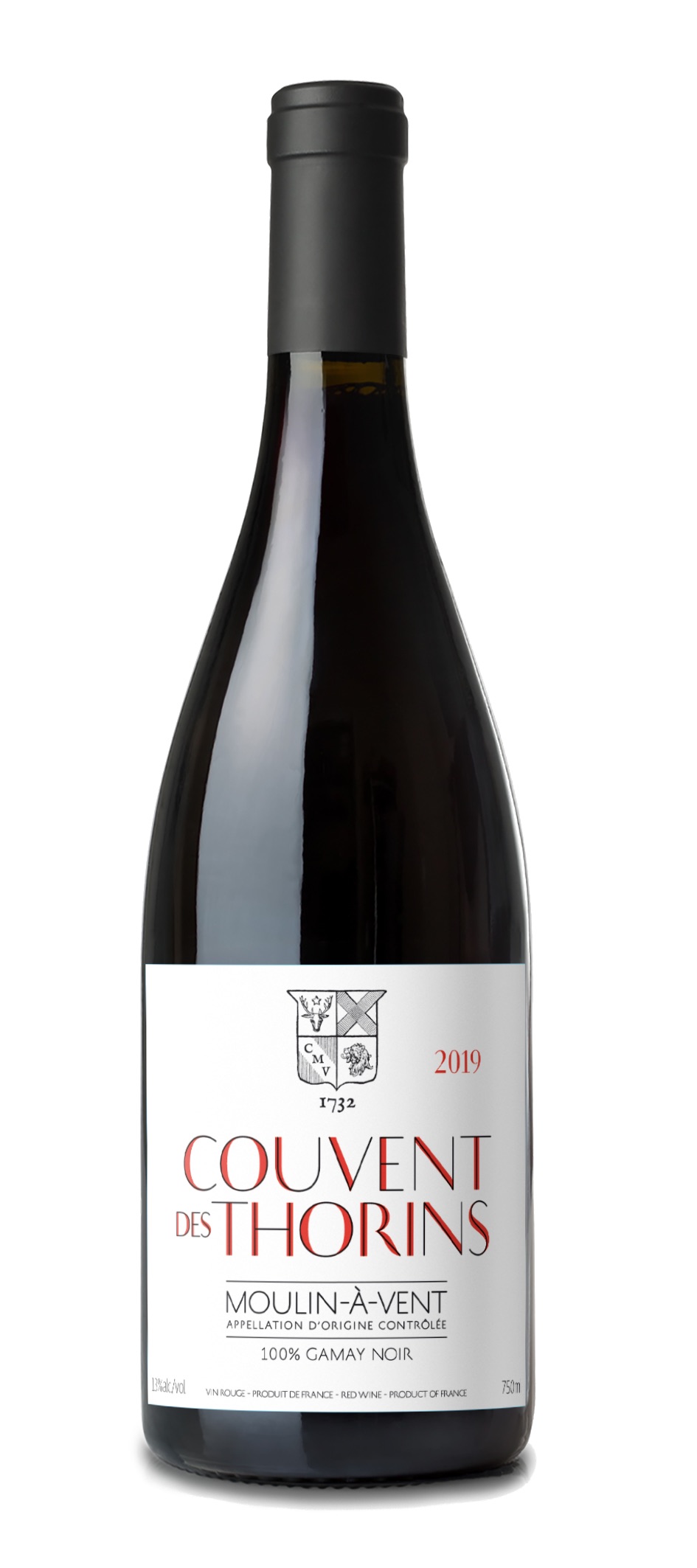 the summer’s heat gave it body
while the fruit emerges like black cherries.
the summer’s heat gave it body
while the fruit emerges like black cherries.
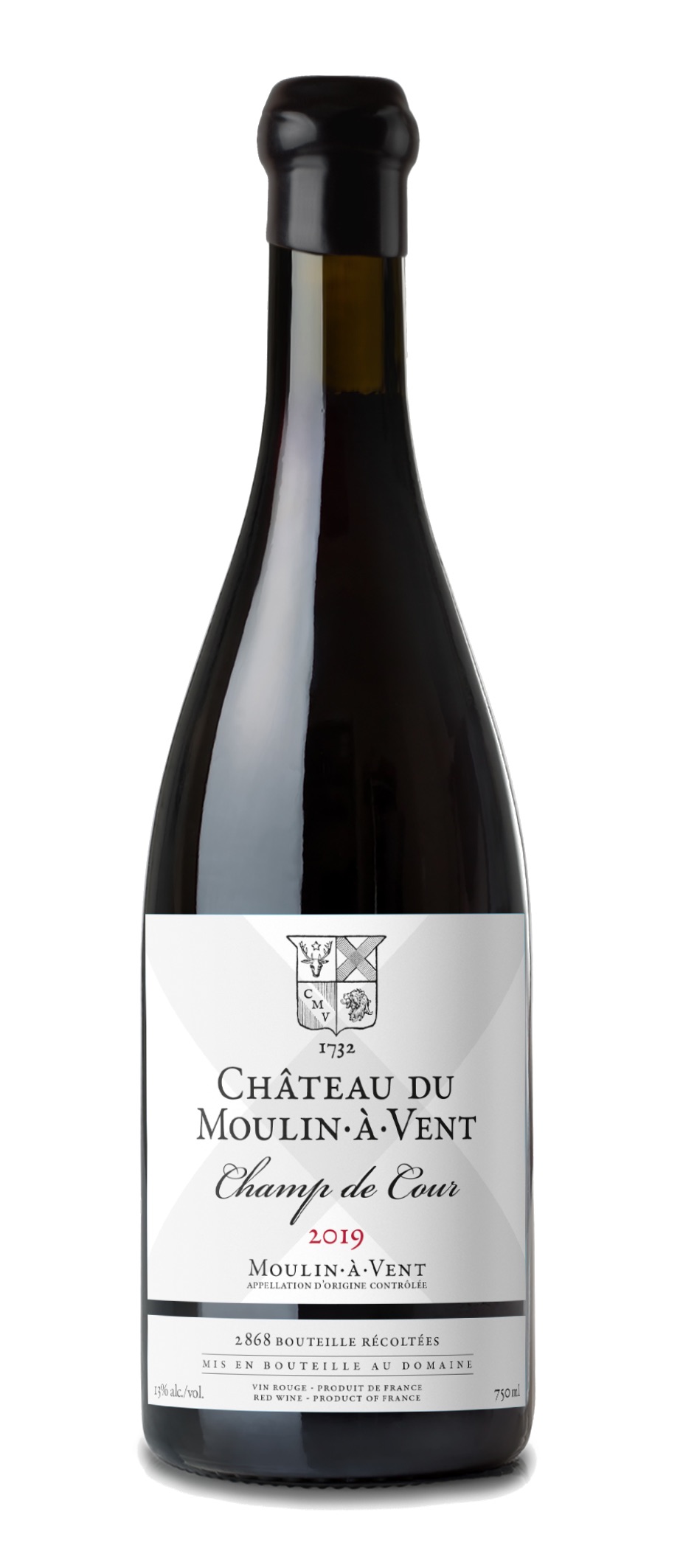 2019 Château du Moulin-à-Vent ($45)—With 13%
alcohol this might be considered a true middleweight
with depth and strength in a velvet glove that makes
it smooth and very satisfying with veal and pork
chops. Its price is a bit daunting, but it reveals
just how good Beaujolais can be.
2019 Château du Moulin-à-Vent ($45)—With 13%
alcohol this might be considered a true middleweight
with depth and strength in a velvet glove that makes
it smooth and very satisfying with veal and pork
chops. Its price is a bit daunting, but it reveals
just how good Beaujolais can be.
2019 'Champ de Cour' ($69)—This was the
most expensive Beaujolais I’ve had in a long time,
with less than 3,000 bottles and 300 magnums made.
Its hillside terroir is protected from harsh winds
and the summer heat was ameliorated somewhat, giving
this wine a real elegance for one from
Moulin-à-Vent. It is ideal with the kind of game
dishes you might otherwise serve a Chambertin
with.
2019 'Les Vérillats' ($59)—Made from just
one vineyard, at a higher altitude and from soil
with a high granite content, which gives it a
delightful minerality that makes it excellent with
hearty stews full of vegetables.
2009 Château du
Moulin-à-Vent ($38)—It’s unlikely you’ll find
this easily at a wine store but I wanted to report
on it because it gives the lie to the myth that
Beaujolais cannot age for long. This wine is 12
years old, made from the grapes of five vineyards,
at 13.5% alcohol, which has helped its longevity. It
is no museum piece, for it still had vibrancy and
was very soft and velvety. I enjoyed it with some
mild French cheeses.
 BLOCK
THAT METAPHOR!
BLOCK
THAT METAPHOR!“The other meats and fish tend to be filled out with vegetables that don’t just complement them but complete them —the craggy breaded pork cutlet with salad of crisp, bitter greens that’s as bracing as a snowball fight."—Pete Welles, “Chicken Reported to Be Doing Well After Successful Restaurant Transplant,” NY Times(2/3/22).”
❖❖❖
Any of John Mariani's books below may be ordered from amazon.com.
 The Hound in Heaven
(21st Century Lion Books) is a novella, and
for anyone who loves dogs, Christmas, romance,
inspiration, even the supernatural, I hope you'll find
this to be a treasured favorite. The story
concerns how, after a New England teacher, his wife and
their two daughters adopt a stray puppy found in their
barn in northern Maine, their lives seem full of promise.
But when tragedy strikes, their wonderful dog Lazarus and
the spirit of Christmas are the only things that may bring
his master back from the edge of despair.
The Hound in Heaven
(21st Century Lion Books) is a novella, and
for anyone who loves dogs, Christmas, romance,
inspiration, even the supernatural, I hope you'll find
this to be a treasured favorite. The story
concerns how, after a New England teacher, his wife and
their two daughters adopt a stray puppy found in their
barn in northern Maine, their lives seem full of promise.
But when tragedy strikes, their wonderful dog Lazarus and
the spirit of Christmas are the only things that may bring
his master back from the edge of despair. WATCH THE VIDEO!
“What a huge surprise turn this story took! I was completely stunned! I truly enjoyed this book and its message.” – Actress Ali MacGraw
“He had me at Page One. The amount of heart, human insight, soul searching, and deft literary strength that John Mariani pours into this airtight novella is vertigo-inducing. Perhaps ‘wow’ would be the best comment.” – James Dalessandro, author of Bohemian Heart and 1906.
“John Mariani’s Hound in Heaven starts with a well-painted portrayal of an American family, along with the requisite dog. A surprise event flips the action of the novel and captures us for a voyage leading to a hopeful and heart-warming message. A page turning, one sitting read, it’s the perfect antidote for the winter and promotion of holiday celebration.” – Ann Pearlman, author of The Christmas Cookie Club and A Gift for my Sister.
“John Mariani’s concise, achingly beautiful novella pulls a literary rabbit out of a hat – a mash-up of the cosmic and the intimate, the tragic and the heart-warming – a Christmas tale for all ages, and all faiths. Read it to your children, read it to yourself… but read it. Early and often. Highly recommended.” – Jay Bonansinga, New York Times bestselling author of Pinkerton’s War, The Sinking of The Eastland, and The Walking Dead: The Road To Woodbury.
“Amazing things happen when you open your heart to an animal. The Hound in Heaven delivers a powerful story of healing that is forged in the spiritual relationship between a man and his best friend. The book brings a message of hope that can enrich our images of family, love, and loss.” – Dr. Barbara Royal, author of The Royal Treatment.
 |
The Encyclopedia of American Food and Drink by John F. Mariani (Bloomsbury USA, $35) Modesty forbids me to praise my own new book, but let me proudly say that it is an extensive revision of the 4th edition that appeared more than a decade ago, before locavores, molecular cuisine, modernist cuisine, the Food Network and so much more, now included. Word origins have been completely updated, as have per capita consumption and production stats. Most important, for the first time since publication in the 1980s, the book includes more than 100 biographies of Americans who have changed the way we cook, eat and drink -- from Fannie Farmer and Julia Child to Robert Mondavi and Thomas Keller. "This book is amazing! It has entries for everything from `abalone' to `zwieback,' plus more than 500 recipes for classic American dishes and drinks."--Devra First, The Boston Globe. "Much needed in any kitchen library."--Bon Appetit. |
"Eating Italian will never be the same after reading John Mariani's entertaining and savory gastronomical history of the cuisine of Italy and how it won over appetites worldwide. . . . This book is such a tasteful narrative that it will literally make you hungry for Italian food and arouse your appetite for gastronomical history."--Don Oldenburg, USA Today. "Italian
restaurants--some good, some glitzy--far
outnumber their French rivals. Many of
these establishments are zestfully described
in How Italian Food Conquered the World, an
entertaining and fact-filled chronicle by
food-and-wine correspondent John F.
Mariani."--Aram Bakshian Jr., Wall Street
Journal.
"Equal parts
history, sociology, gastronomy, and just
plain fun, How Italian Food Conquered the
World tells the captivating and delicious
story of the (let's face it) everybody's
favorite cuisine with clarity, verve and
more than one surprise."--Colman Andrews,
editorial director of The Daily
Meal.com. "A fantastic and fascinating
read, covering everything from the influence
of Venice's spice trade to the impact of
Italian immigrants in America and the
evolution of alta cucina. This book will
serve as a terrific resource to anyone
interested in the real story of Italian
food."--Mary Ann Esposito, host of PBS-TV's
Ciao
Italia. "John Mariani has written the
definitive history of how Italians won their
way into our hearts, minds, and
stomachs. It's a story of pleasure over
pomp and taste over technique."--Danny Meyer,
owner of NYC restaurants Union Square
Cafe, The Modern, and Maialino.
|
 |
 |
 |
 |
 |
 |
 Everett Potter's Travel Report:
Everett Potter's Travel Report: 
 Eating Las
Vegas JOHN CURTAS has been covering
the Las Vegas food and restaurant scene
since 1995. He is the co-author of EATING LAS
VEGAS – The 50 Essential Restaurants (as
well as the author of the Eating Las
Vegas web site: www.eatinglasvegas.
He can also be seen every Friday morning as
the “resident foodie” for Wake Up With the
Wagners on KSNV TV (NBC) Channel 3 in
Las Vegas.
Eating Las
Vegas JOHN CURTAS has been covering
the Las Vegas food and restaurant scene
since 1995. He is the co-author of EATING LAS
VEGAS – The 50 Essential Restaurants (as
well as the author of the Eating Las
Vegas web site: www.eatinglasvegas.
He can also be seen every Friday morning as
the “resident foodie” for Wake Up With the
Wagners on KSNV TV (NBC) Channel 3 in
Las Vegas.
MARIANI'S VIRTUAL GOURMET
NEWSLETTER is published weekly. Publisher: John Mariani. Editor: Walter Bagley. Contributing Writers: Christopher
Mariani, Misha Mariani, John A. Curtas, Gerry Dawes, Geoff Kalish.
Contributing
Photographer: Galina Dargery. Technical
Advisor: Gerry
McLoughlin.
If you wish to subscribe to this
newsletter, please click here: http://www.johnmariani.com/subscribe/index.html
© copyright John Mariani 2022

